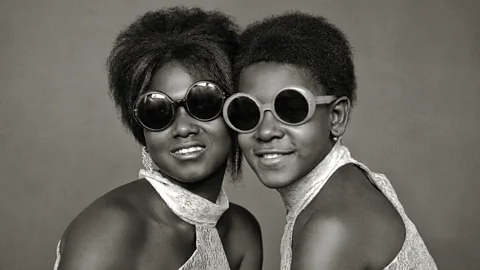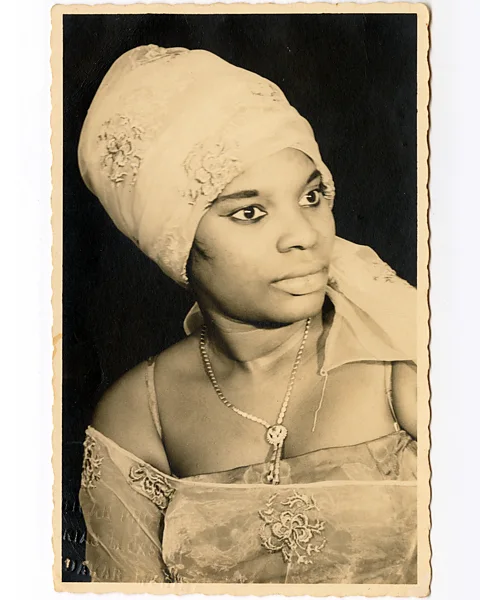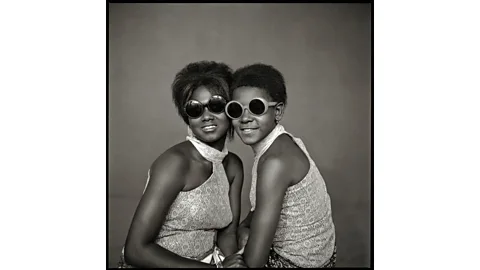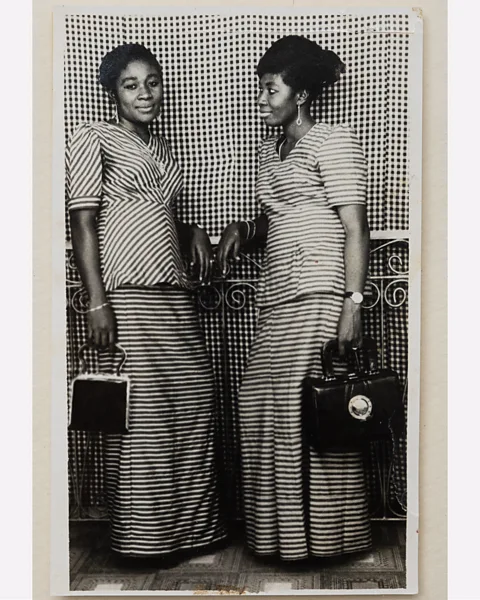Stunning images of elegance and strength
 Abdourahmane Sakaly/ Courtesy of The McKinley Collection/The African Lookbook
Abdourahmane Sakaly/ Courtesy of The McKinley Collection/The African LookbookA book of portraits captures the style and resilience of West African women over the decades. Its author Catherine McKinley tells the story behind the collection.
When I was a teen I travelled from the US to Scotland with my family. On our first night in Edinburgh, we sat in a pub across from several Nigerian couples, resplendent in bell bottoms and African prints, paired with plaids and Harris tweeds. They were spinning the traditional textures into something chic, subversive and all their own. One woman wore a Shetland sweater under her embroidered dress, a wool scarf wrapped stylishly on her head. I couldn't take my eyes off of her. It was a simple new logic – style and self definition over everything.
More like this:
This woman came back to me in sharp focus again, years later. For almost 30 years I have collected photographs of African women. It began unconsciously, with the parting gifts of new friends I met as I travelled in West Africa, in Togo, Ghana, Burkina Faso and Niger. Studio photos and even point-and-shoot technology were expensive, and so taking photos was intentional and an occasion to dress. Scattered among these were priceless studio shots dating from the 1950s, 60s and 70s from women I subsequently got to know very well over the years – well enough for me to call them my aunties.
 Yousseff Safieddine, Senegal/ The McKinley Collection/The African Lookbook
Yousseff Safieddine, Senegal/ The McKinley Collection/The African LookbookAt the time, they'd ordered the prints in multiples in order to share among friends or perhaps to be used in marriage bids, and still had copies to spare. Then, in the late 1990s, Western art audiences were introduced to African master photographers Malick Sidibe and Seydou Keita whose images, very similar to the aunties', were transformed from intimate personal mementos into large-size – and in the case of Keita, nearly life-size – art objects. I returned to my cherished boxes of photos and began to look at them anew.
More staid, with the subjects more formally dressed and perfectly groomed, and keeping with the modest, classic conventions of the studio, my collection of photos did not share the insouciance and determined subversion that I'd witnessed in Scotland, and looked for ever since. But I had seen it alive on the streets of many West African cities, at funerals and family gatherings, fashion shows, and even in the way a plastic bag would be fashioned elegantly on the head of a woman standing selling in the rain. The plastic became like mink.
 Courtesy of The McKinley Collection/The African Lookbook
Courtesy of The McKinley Collection/The African LookbookWhat I was learning is that resistance is often there in African fashion, it just needs to be noticed. Two powerful tools of Empire – the sewing machine and the camera – both arrived along the Atlantic coast in the mid-1800s and were used initially in campaigns of violence, coercion, typology making and control. African women, from the very first encounters with these tools, would have approached them with an awareness of this power.
With my discovery of Keita I began to collect ionately – led very much by a love of fashion, and by a desire to make new sense of the world through the lead of my heroine in Edinburgh. It was the 1970s when I went to Edinburgh, and the images of Africa fed to us at that time swung from two poles: National Geographic, which arrived in its brown-paper cover, suggesting something out of bounds, which was manifest in the photographs baring African women's bodies.
 Seydou Keita/SKPE-Courtesy CAAC- The Pigozzi Collection
Seydou Keita/SKPE-Courtesy CAAC- The Pigozzi CollectionThen there were Ebony and Jet magazines, evidence of another continent – black US celebrities at Independence celebrations, "hot" African-inspired fashions for the catwalk, commercial ads featuring the regalia of pre-colonial kings and queens. This Africa was a heaving, glorious thing, like the chests of actors LaVar Burton and Cicely Tyson in the 1970s TV series Roots. By the 1980s this Africa was replaced with images of poverty and war.
Moment of enthralment
I've come to realise that if you slow down to read them, they tell their own stories, different from those Western magazines, whatever their political position, where the endless, brightly-dressed women are hard to discern under the surface of their presentation as archetypal mothers, sages, anthropologised tradition-keepers and nudes.
 Abdourahmane Sakaly/ Courtesy of The McKinley Collection/The African Lookbook
Abdourahmane Sakaly/ Courtesy of The McKinley Collection/The African LookbookHere, we encounter faces at the same time as the dress. The faces are storied; the dresses and lighting set them off, instead of burying them. We take them in as intently as the drip of fashion. Resolutely, splendidly clad, in these images the objectifying elements are not present. Every scene is a highly constructed one, caught in a narrow moment of enthralment and detachment from what is brewing and being plotted in colonial and post-colonial situation rooms. Independence. Decolonisation. A social revolution by the young against the Pretenders, as the youth would call their parents, holding Keita's bourgeois studio props. What's not in the lens is the government conspiring with a nation's elders to flog and send for "re-education" those mini-skirted tresers and Afroed heads.
The women in African photographers' lenses were in control of their image; nudity was replaced with high-fashion clothing which could compete with European luxury, and many of the women would have sewn their clothing themselves. Those images too have the danger of becoming fetishised but the dignity of the photographs, and especially of the uncoerced sitters, insists that we consume them very differently.
 Courtesy of The McKinley Collection/The African Lookbook
Courtesy of The McKinley Collection/The African LookbookWhere is the resistance? It is in what is worn – the choice of textiles, a button hole, simple nuances of colours or an altered line. It is in the choosing of a wax cloth or a threaded style that references, all at once, new city architecture, an outlaw Afrobeat song, and a warning to a rival. A black-and-white pattern evoking the architecture of the mosque and the earthly reminder to fix one's eye not on human beauty but on the divine.
And so I collect photographs from Africa. And collect. With a hunger for the world of stories and for the remarkable endless possibilities for fashion that run through them. For the way images can do what writers and their audiences do together: write beyond the ending, leading you into a universe all your own. There is such a wide web of African photography. It's become so wide it is hard to characterise all the types of work, and in them is all of the world of African style.
 Courtesy of The McKinley Collection/The African Lookbook
Courtesy of The McKinley Collection/The African LookbookEvery image in my collection is a love letter to African women, and the endless ways they upturn things, all with a penchant for newness, for modernity. Looking forward and crushing the past.
If you would like to comment on this story or anything else you have seen on BBC Culture, head over to our Facebook page or message us on Twitter.
And if you liked this story, sign up for the weekly bbc.com features newsletter, called The Essential List. A handpicked selection of stories from BBC Future, Culture, Worklife and Travel, delivered to your inbox every Friday.
